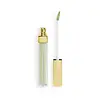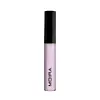Revolution Beauty Ultimate Radiant Colour Corrector Versus Moira Beauty Lavish Color Correcting Concealer
What's inside
What's inside
 Key Ingredients
Key Ingredients

 Benefits
Benefits

 Concerns
Concerns

 Ingredients Side-by-side
Ingredients Side-by-side

Water
Skin ConditioningDimethicone
EmollientC12-15 Alkyl Benzoate
AntimicrobialMethyl Methacrylate Crosspolymer
Nylon-12
Glycerin
HumectantMethylpropanediol
SolventIsododecane
EmollientBoron Nitride
AbsorbentPEG-10 Dimethicone
Skin ConditioningMica
Cosmetic ColorantPhenoxyethanol
PreservativeDimethicone/PEG-10/15 Crosspolymer
Triethoxycaprylylsilane
Dimethicone Crosspolymer
Emulsion StabilisingCaprylyl Glycol
EmollientDisodium EDTA
Ascorbic Acid
AntioxidantEthylhexylglycerin
Skin ConditioningNiacinamide
SmoothingTocopherol
AntioxidantDipropylene Glycol
HumectantSodium Citrate
BufferingSodium Hyaluronate
HumectantCI 77891
Cosmetic ColorantCI 77007
Cosmetic ColorantCI 77491
Cosmetic ColorantCI 77288
Cosmetic ColorantCI 77492
Cosmetic ColorantCI 77499
Cosmetic ColorantWater, Dimethicone, C12-15 Alkyl Benzoate, Methyl Methacrylate Crosspolymer, Nylon-12, Glycerin, Methylpropanediol, Isododecane, Boron Nitride, PEG-10 Dimethicone, Mica, Phenoxyethanol, Dimethicone/PEG-10/15 Crosspolymer, Triethoxycaprylylsilane, Dimethicone Crosspolymer, Caprylyl Glycol, Disodium EDTA, Ascorbic Acid, Ethylhexylglycerin, Niacinamide, Tocopherol, Dipropylene Glycol, Sodium Citrate, Sodium Hyaluronate, CI 77891, CI 77007, CI 77491, CI 77288, CI 77492, CI 77499
Water
Skin ConditioningDimethicone
EmollientCyclopentasiloxane
EmollientButylene Glycol
HumectantPEG-10 Dimethicone
Skin ConditioningPropylene Glycol
HumectantPhenyl Trimethicone
Skin ConditioningIsododecane
EmollientCetyl PEG/PPG-10/1 Dimethicone
EmulsifyingCaprylyl Methicone
Skin ConditioningNylon-12
Dimethicone Crosspolymer
Emulsion StabilisingSodium Chloride
MaskingPhenoxyethanol
PreservativeDisteardimonium Hectorite
StabilisingTriethoxycaprylylsilane
Sodium Dehydroacetate
PreservativeTriethyl Citrate
MaskingEthylhexylglycerin
Skin ConditioningTocopherol
AntioxidantTitanium Dioxide
Cosmetic ColorantCI 77499
Cosmetic ColorantCI 77007
Cosmetic ColorantCI 75470
Cosmetic ColorantWater, Dimethicone, Cyclopentasiloxane, Butylene Glycol, PEG-10 Dimethicone, Propylene Glycol, Phenyl Trimethicone, Isododecane, Cetyl PEG/PPG-10/1 Dimethicone, Caprylyl Methicone, Nylon-12, Dimethicone Crosspolymer, Sodium Chloride, Phenoxyethanol, Disteardimonium Hectorite, Triethoxycaprylylsilane, Sodium Dehydroacetate, Triethyl Citrate, Ethylhexylglycerin, Tocopherol, Titanium Dioxide, CI 77499, CI 77007, CI 75470
Ingredients Explained
These ingredients are found in both products.
Ingredients higher up in an ingredient list are typically present in a larger amount.
This pigment is called Ultramarine blue lazurite. It gives a saturated blue color, but can be used to create other colors as well.
According to the manufacturer, it is usually made from kaolin, sodium sulfate, sodium carbonate, sulfur, and charcoal.
Ci 77499 is also hydrated iron III oxide. It is created from mixing red and black iron oxides. This helps give shades of darkness to a product.
Iron III oxides are classified as inorganic chemicals for coloring.
Dimethicone is a type of synthetic silicone created from natural materials such as quartz.
What it does:
Dimethicone comes in different viscosities:
Depending on the viscosity, dimethicone has different properties.
Ingredients lists don't always show which type is used, so we recommend reaching out to the brand if you have questions about the viscosity.
This ingredient is unlikely to cause irritation because it does not get absorbed into skin. However, people with silicone allergies should be careful about using this ingredient.
Note: Dimethicone may contribute to pilling. This is because it is not oil or water soluble, so pilling may occur when layered with products. When mixed with heavy oils in a formula, the outcome is also quite greasy.
Learn more about DimethiconeDimethicone Crosspolymer is a silicone created by modifying dimethicone with hydrocarbon side chains. Due to its large size, it does not penetrate skin. It is considered non-occlusive.
Dimethicone Crosspolymer is used to stabilize and thicken products. It also helps give products a silky feel.
Ethylhexylglycerin (we can't pronounce this either) is commonly used as a preservative and skin softener. It is derived from glyceryl.
You might see Ethylhexylglycerin often paired with other preservatives such as phenoxyethanol. Ethylhexylglycerin has been found to increase the effectiveness of these other preservatives.
Isododecane is a fragrance, emollient, and solvent.
As an emollient, it helps your skin stay soft and hydrated. Emollients help trap moisture into your skin.
Isododecane's role as a solvent makes it a great texture enhancer. It spreads smoothly on skin and does not leave a sticky feeling behind. Isododecane also helps prevent color transfer in makeup products.
Isododecane is not absorbed into skin.
Learn more about IsododecaneNylon-12 is a polymer. It is derived from 12-aminododecanoic acid, an omega-amino fatty acid
According to a manufacturer, it is a talc substitute. Like talc, nylon-12 gives products a satin feel. The manufacturer also claims this ingredients does not block pores and has moderate oil absorption.
This ingredient may not be reef-safe.
Learn more about Nylon-12Peg-10 Dimethicone is silicone with conditioner and emulsifier properties. It mostly acts as an emollient in skincare and and humectant in haircare.
According to the manufacturer, acidic formulations decrease the stability of this ingredient. It works best in neutral or near neutral formulations.
Phenoxyethanol is a preservative that has germicide, antimicrobial, and aromatic properties. Studies show that phenoxyethanol can prevent microbial growth. By itself, it has a scent that is similar to that of a rose.
It's often used in formulations along with Caprylyl Glycol to preserve the shelf life of products.
Tocopherol (also known as Vitamin E) is a common antioxidant used to help protect the skin from free-radicals and strengthen the skin barrier. It's also fat soluble - this means our skin is great at absorbing it.
Vitamin E also helps keep your natural skin lipids healthy. Your lipid skin barrier naturally consists of lipids, ceramides, and fatty acids. Vitamin E offers extra protection for your skin’s lipid barrier, keeping your skin healthy and nourished.
Another benefit is a bit of UV protection. Vitamin E helps reduce the damage caused by UVB rays. (It should not replace your sunscreen). Combining it with Vitamin C can decrease sunburned cells and hyperpigmentation after UV exposure.
You might have noticed Vitamin E + C often paired together. This is because it is great at stabilizing Vitamin C. Using the two together helps increase the effectiveness of both ingredients.
There are often claims that Vitamin E can reduce/prevent scarring, but these claims haven't been confirmed by scientific research.
Learn more about TocopherolTriethoxycaprylylsilane is a silicone used to bind and stabilize ingredients.
As an emulsifier, it helps prevent ingredients from separating. This can help elongate the shelf life of products.
Triethoxycaprylylsilane is often used to coat mineral sunscreens ingredients to help give a better feel. It also helps reduce oxidative stress in sunscreens.
Learn more about TriethoxycaprylylsilaneWater. It's the most common cosmetic ingredient of all. You'll usually see it at the top of ingredient lists, meaning that it makes up the largest part of the product.
So why is it so popular? Water most often acts as a solvent - this means that it helps dissolve other ingredients into the formulation.
You'll also recognize water as that liquid we all need to stay alive. If you see this, drink a glass of water. Stay hydrated!
Learn more about Water